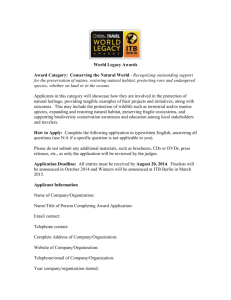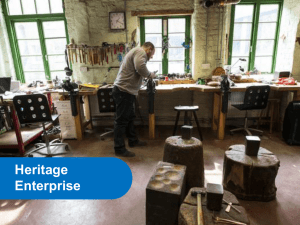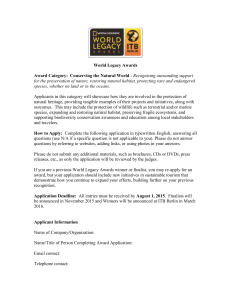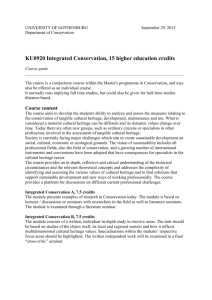Conserving Built Heritage of Lo Manthang and Upper
advertisement
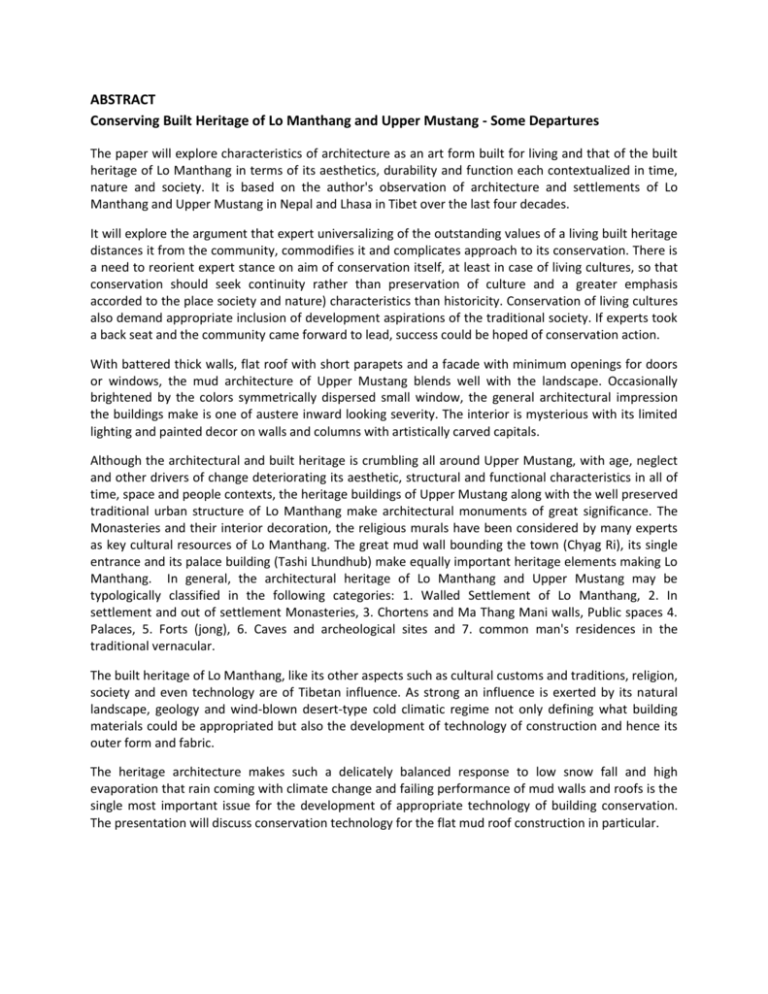
ABSTRACT Conserving Built Heritage of Lo Manthang and Upper Mustang - Some Departures The paper will explore characteristics of architecture as an art form built for living and that of the built heritage of Lo Manthang in terms of its aesthetics, durability and function each contextualized in time, nature and society. It is based on the author's observation of architecture and settlements of Lo Manthang and Upper Mustang in Nepal and Lhasa in Tibet over the last four decades. It will explore the argument that expert universalizing of the outstanding values of a living built heritage distances it from the community, commodifies it and complicates approach to its conservation. There is a need to reorient expert stance on aim of conservation itself, at least in case of living cultures, so that conservation should seek continuity rather than preservation of culture and a greater emphasis accorded to the place society and nature) characteristics than historicity. Conservation of living cultures also demand appropriate inclusion of development aspirations of the traditional society. If experts took a back seat and the community came forward to lead, success could be hoped of conservation action. With battered thick walls, flat roof with short parapets and a facade with minimum openings for doors or windows, the mud architecture of Upper Mustang blends well with the landscape. Occasionally brightened by the colors symmetrically dispersed small window, the general architectural impression the buildings make is one of austere inward looking severity. The interior is mysterious with its limited lighting and painted decor on walls and columns with artistically carved capitals. Although the architectural and built heritage is crumbling all around Upper Mustang, with age, neglect and other drivers of change deteriorating its aesthetic, structural and functional characteristics in all of time, space and people contexts, the heritage buildings of Upper Mustang along with the well preserved traditional urban structure of Lo Manthang make architectural monuments of great significance. The Monasteries and their interior decoration, the religious murals have been considered by many experts as key cultural resources of Lo Manthang. The great mud wall bounding the town (Chyag Ri), its single entrance and its palace building (Tashi Lhundhub) make equally important heritage elements making Lo Manthang. In general, the architectural heritage of Lo Manthang and Upper Mustang may be typologically classified in the following categories: 1. Walled Settlement of Lo Manthang, 2. In settlement and out of settlement Monasteries, 3. Chortens and Ma Thang Mani walls, Public spaces 4. Palaces, 5. Forts (jong), 6. Caves and archeological sites and 7. common man's residences in the traditional vernacular. The built heritage of Lo Manthang, like its other aspects such as cultural customs and traditions, religion, society and even technology are of Tibetan influence. As strong an influence is exerted by its natural landscape, geology and wind-blown desert-type cold climatic regime not only defining what building materials could be appropriated but also the development of technology of construction and hence its outer form and fabric. The heritage architecture makes such a delicately balanced response to low snow fall and high evaporation that rain coming with climate change and failing performance of mud walls and roofs is the single most important issue for the development of appropriate technology of building conservation. The presentation will discuss conservation technology for the flat mud roof construction in particular. Conserving Architectural Heritage of Lo Manthang and Upper Mustang - Some Departures Fig 1: Lo Manthang Photo: Neel Kamal Chapagain [My tryst with architecture in Mustang started with a research made of Marfa in January of 1977. The immediate outcome of that was a booklet titled "A Monograph of Marfa" which briefly documents the settlement and the house form there in (Tiwari, 1977). In 1993, on assignment of KMTNC (now Nepal Trust for Nature Conservation, NTNC) I made a visit Lo Manthang to prepare a conservation plan for Thubchen Monastery. In 1991, Lo Manthang and Upper Mustang had been opened for Tourism under ACAP (Annapurna Conservation Area Project) management and part of the fees paid by the tourists was to be used for the conservation works. At this time I also designed one of the first 'architectural intervention' made by ACAP, the Museum of Traditions at Jomosom. The Documentation and Conservation Note was submitted to the KMTNC and ACAP management in April 1993. In 2004, I visited Lhasa and had the first hand look at Tibetan architecture and building traditions said to have been the basis of architectural heritage of Lo Manthang. This visit developed into an association with Tibet University's Department of Architecture (School of Engineering) through which I continued to work on the documentation and study of Tibetan traditional architecture and settlement (Gyantse) until recently. Tibet University and Institute of Engineering now are working on a proposal to do a joint research on Trans-Himalayan architecture and settlement taking the case of Lo Manthang. And what I present are thoughts coming out of these experiences] Although the architectural and built heritage is crumbling all around Upper Mustang, with age, neglect and drivers of change deteriorating its aesthetic, structural and functional characteristics challenged in all of time, space and people contexts, the heritage buildings of Lo Manthang along with its well preserved traditional urban structure make an architectural monument of great significance (Hansen, 1993). The Monasteries and their interior decoration, the religious murals have been considered by many experts as key cultural resources of Lo Manthang. The great mud wall bounding the town (Chyag Ri), its single entrance and its palace building (Tashi Lhundhub) make equally important heritage elements making Lo Manthang. The land use zoning of the town into the Monastic sector in the northwest and the Royal sector on the southern half and the latter's division into four neighbourhoods of Guthang in the northeast, Dolma Lhakhang in southeast, Potaling in southwest and Jyathang in north-west and the central specific monuments located in these quarters are indicative of the doctrinal planning governing the idea of an walled capital town. Fig 2: Settlement Structure of Lo Manthang Fig 3: Charang Monastery from: TSARANG en "Feltrapport" (Andersen, 1994) With battered thick walls, flat roof with short parapets and a facade with minimum openings for doors or windows, the mud architecture of Upper Mustang blends well with the landscape. Occasionally brightened by the colors symmetrically dispersed small window, the general architectural impression the buildings make is one of austere inward looking severity. The interior is mysterious with its limited lighting and painted decor on walls and columns with artistically carved capitals. A variety of minerals in earth gives rise to specialized properties to suit differing needs e.g. yellow earth is used for wall, 'Baga' earth for inner wall surfaces and 'Aga' earth for floor and roof (Yan, 2004). Mixing the locally available soils with different properties in certain proportions and using appropriate water ratio and compaction through calculated tamping, the traditional craftsmen and masons of Lo Manthang have long perfected construction of hard floors and waterproof flat roofs. Very hard abrasion resistant floor can be observed in many monasteries in Mustang. An experiment of testing cubes made by varying proportion, mix, water ratio, compression and curing period using four kinds of soil (identified and collected by the local masons) at the Soil Laboratory of Institute of Engineering in 1993 showed that hardness and strength capable of matching modern building materials could be achieved. The characteristics and value of the built heritage of any culture and the demands of conservation can be studied under the three dimensional matrix already described above. I would like to discuss the problems of conservation from the perspective of materials and technology in this paper in some detail, leaving the other issues for others: 1. Characteristics Dimension - aesthetics of form, structure/materials, function 2. Values Dimension - time, space and people context and 3. Deterioration agents/Conservation need generators (age, neglect, change drives) Architecture is an art form built for living and so values of built culture encompass the three definitive requirements of architecture e.g. aesthetics (art form), durability (strength and longevity) and function. Also, as an objects built in history to support human activities in the natural landscape (land form, geology and climate) of its setting, the values of built heritage lies not only in 'time' specific historicity but also in its specificity to 'space' and 'people'. Such being the nature of built heritage, I find the expert/official idea of universalizing the outstanding values of living built heritage contradicting the very essence of heritage values - time, space and people. Conservation of built heritage, therefore, should consider all of its artistry, craft and construction technology, and function, as reflected in the architecture of buildings, of monuments, of public places and, in totality of the settlement in terms of its specificity to time, place and people. The architecture of Lo Manthang and Upper Mustang is not only a result of its social (and religious) landscape but also of its natural landscape, the geology and wind-blown desert-type cold climatic regime not only defining what building materials could be appropriated but also the development of technology of construction and hence its outer form and fabric. The making of the activities inside and the place outside is thus as much affected by the society as the nature around. Indeed, it may be sobering to ponder on how much has nature contributed to the making of the society in Lo Manthang in the first place as Giuseppe Tucci did (Tucci, 1993): But here in the annihilating immensity of space it is easy to understand how the Tibetans have accepted and kept to the metaphysics of the Great Vehicle which reduces man and objects to shadows seen in a dream. What is man on these plains which disappear beyond the horizon, in the cosmic solitude, in this vastness, where even the mountains seem like little hills? The built heritage of Lo Manthang, like its other aspects such as cultural customs and traditions, religion, society and even technology are of Tibetan influence. Tibetan influences have been claimed from both sides from as early as seventh century and its resurgence in the fifteenth century. Most of the built heritage of the area are developed of this second period of Tibetan influence when the Sakya-pa nGor religious sub-sect was founded under Lama Kun-dga-bzang-po (Jest, 1981) and the rise of the Mustang state under King Ama Pal. The Jyampa Gumba monastery, built by the second king Aa Goyen Tsanpo in 1447, (Prayag Raj Sharma, 2044 BS) is possibly the oldest structure within the walled town today. Sharma and Gurung's 'Blo(Mustang)ko Samskritik Sampada' makes a comprehensive study of the built heritage of Lo Manthang. It classifies the architectural heritage of Lo Manthang and Upper Mustang in the following categories: 1. Walled Settlement of Lo Manthang, 2. In Town Monasteries, 3. Secluded Monasteries 4. Chortens and Ma Thang Mani walls, 5. Palaces, 6. Forts (jong), and 7. Caves The list could be completed in a typological sense by adding (8) associated settlement spaces of some of the public buildings (9) common man's residences in the traditional vernacular and (10) archeological sites such as that of Tukuche Chokhopani. The above classification is virtually based on functional characteristics, the material and aesthetic characteristics being sort of common but of as much consequence. As a matter of fact, the form and aesthetic characteristic of this architecture is largely a result of its building materials and technology as they seek to contain the harsh nature out and make the building durable and strong within the performance standards sought. The built architecture of Lo Manthang and Upper Mustang is materialized with mud, stone and timber as they in combination seek to keep the snow, the wind, the sand and the cold out. In darkening the interior spaces, it may even have been seeking to keep the ultraviolet radiation out. The geology and climate have clearly determined the building form. ***** The best time to study for conservation of the built heritage in Lo Manthang and Upper Mustang should be in the coldest depths of winter, when this cosmic solitude is at its deepest. For, it is in such state that the essence of this architecture expresses itself most eloquently. And this is the first of the changes in approach to conservation that we the experts need to make. Another conceptual change in the modern idea of conservation is called for by the traditional society built as they are, around the idea of cyclical and auto-renewing time. Within such societies, there already exists the traditional approach to "cultural resource protection and management that is founded in the concept of continuity rather than preservation. This is based on a world view represented by a sense of place rather than a sense of history and embedded in indigenous knowledge systems associated with traditions, beliefs and intangible values of the people". (Thakur, 2009) I would think for conservation of heritage in Lo Manthang should be seen, not as an act of preservation of a expression coming from a fixed point in past time, but rather as ways of bringing about a continuity of such expressions into the future through the acts of value to the present. It is also worthwhile for this international symposium to remember that the classification of heritage into various categories such as World Heritage1, National Heritage and/or (may be in the coming years) as State Heritage distances the heritage from the 'owner' community and introduces into the culture so reified an economic worth that is capitalized through the visiting outsider/tourist. For example, with WHS inscription, the state party becomes officially responsible for coordinating conservation, while the commercial benefits of tourism is hard to be shared into the owner community. It may be noted here that while limited eco-tourism have been successful in conserving nature, cultural tourism remains a double edged sword that experts cannot fend on behalf of the owner community. It is the living aspects of culture that will be on the block. Fig. 4: The problem of 'expert' universalizing outstanding values of living built heritage [UNESCO-event 494-1.pdf] While working on the conservation of living cultures, the need to incorporate the present social value, that its living component, into the historical values becomes paramount as we should require continuity of culture as a prime outcome of conservation in traditional society. This approach of continuing the 1 It should be remembered that OUV is defined as an expert understanding that makes the value of heritage break the boundaries of nations, generations and ethnicities. sense of place rather than a sense of history has a potential of integrating people and their development aspirations into the conservation process. While encouraging and ensuring community interest and involvement, it can ultimately make the community take lead responsibility for conservation. Incorporating present interests and values of the community and putting them in the forefront will be key to the expansion of conservation action in Lo Manthang. Preservation psyched monument based conservation approach can hardly be expected to ensure conservation of the architectural heritage of Lo Manthang and Upper Mustang, at least those of which that is still lived in, whether they be the houses, town wall, the monasteries and its squares with Chortens or the palace and its forecourt. In the case of the monument zones of KWVHS too, a partial preservation of the vernacular architecture that provided the ambience to the spaces would have been possible if due consideration of continuity, livingness and development needs had been made in developing building controls. Experience of conservation planning in KVWHS evidences that any community support and involvement is contingent upon the incorporation of living aspects of culture and accepting changes that 'enhance' the value of the heritage in the eyes of the community but which is often rejected as contrary to principles of conservation in the official or expert eye. In addition, a good and visible factoring in of developmental/growth interest into conservation planning is paramount to its acceptance and successful implementation. The development and enhancement interest of the community results from the changing function and durability/ material performance demanded of the heritage building and the need to change is highest at the level of the house and lessens with the object and context of conservation at the settlement level, urban places and monument. It would seem that preservation of aesthetic character of monuments is least affected by development, while growth and development interests increase as we consider the functional and performance aspects of the heritage and as the scale of conservation action progresses from the monuments to public place to settlements and buildings still used for living by the present society. ***** Researchers in Tibet have worked further in developing the performance of the materials and technology and their results are still more encouraging. Some such research outcomes that can have far reaching results in conserving the traditional architectural and constructional heritage are: 1. Careful consideration of preservation of Monumental buildings Although initial Chinese attempts at conservation of Tibetan heritage could be challenged from their lack of sensitivity towards historical advancements and culture, with the passage of time and a more acceptable definition and incorporation of authenticity in Tibetan traditional architecture and culture, things are changing for the better as the technologies become more sensitive to preservation. 2. Dealing with the climate change and leakage of roof becomes an important issue of research and some significant attempts to improve property of locally available ingredients materials have been made in addition to research on soil for building walls and for inner finish. Traditionally moisture management on roof is usually a balanced combination of drainage and water proofing, creating a modern understanding of material performance in terms of compression, tension and permeability becomes important in not being dismissive about the performance of traditional technology. Research has shown that such properties can be significantly enhanced through modern knowledge. One sample result has shown that (a) compressive strength of 6.5 Mpa can be augmented with additives to 19.9 Mpa (b) tensile strength of 0.31 Mpa with additives can be improved to 5.4 Mpa and (c) the anti-permeability level of 0.1 Mpa with additives can be raised to 0.3 Mpa. (Megapascals/Mpa= Measures per area). The additives were used to change the composition ratio of chemical ingredients such as CaO, SiO2, Fe2O3, Al2O3 etc in the soil and the tamping methods used sought a balance between mix-ratio of materials, water-ratio and degree of tamping. Climate change, the changes in precipitation and evaporation, that it has come about affects the depth of finishing roof layer significantly. Addition of an untamped 'flexible' layer between the tamped layer and the yellow earth roof adds to the performance significantly. Still the water absorbing property of Aga earth is a problem and a brush applied coat of colorless waterproofing chemical on top can significantly. In Tibet, the five layered construction of Aga roof is recommended in conservation works. We can contrast these with some of things that we as experts have done at our very own monument of Thubchen (Sanday, 2013; Bhattarai, 2013) and learn a few things from across the border. How do we the nun-mato in Mustang? In Lo, the failure of this repair process has actually been reduction of roof thickness every season as the snow is shoveled out. Either way unevenness, sagging, moisture pools get created and roof is quickly destroyed through the drying, freezing and wetting processes. One wonders how much of such rainfall, snowfall and evaporation data was made use of? How are we doing elsewhere? (Gutchow, 1992) and what are the current thoughts of NTNC? How do we deal with the pressures of development and the road? How do we factor in local aspirations for change and for modernity? Should its remain the last outpost? ***** Mustang as a heritage is both a creation of nature and of man and his culture. It's both sides are equally unique and authentic and seek nomination as a WHS. Although some may see similar natural and cultural characteristics in several sites in Tibet, from a Nepalese perspective, it is the only one district of Nepal that lies on the other side of the Himalayas and may be world's only window on Tibet. The walled town of Lo Manthang and its architectural and cultural representation of fifteenth century as typified by the monasteries of Jhyampa and Thubchen, the palace of the Rajah, and the residential townscape are unique in its own way - a Tibetan macro-settlement morphology of zhong, monastery and the settlement with a difference. Lo Manthang tells the story of the continuing linkage of Tibet, Nepal and the Indian sub-continent, its Buddhism and its Hinduism. Between Muktinath in Mustang and Kailash in Tibet and through its other 'gaps and valleys which eat into and actually overcome the barrier of the Himalayas, many of both hues, the Buddhist diaspora and the Hindu pilgrims, must have walked since much before and long after the Sinja Malla Kingdom straddled the local Himalayas for a brief time in history. May be since the very beginning, as the caves of Mustang seem to tell, Mustang has been the sojourn of early man. Lo Manthang was at the crossroads in its hay days and it is again found itself on the crossroads now but with a difference. While its earlier experience gave us the possibility to partake of the trans-Himalayan cultural movement, the silk road and the cotton trail, if you like, the more recent experience has brought serious concerns for conservation to the fore while giving Mustang a taste of the contemporary and the rest of the world a taste of the local landscape, culture and nature. Andersen, J. (1994). Tsarang en 'Feltrapport'. Kobenhavn: Institute of Restoration, School of Architecture, Royal Danish Academy of Fine Arts. Azevedo, A. A. (1999). The Old City of Lhasa. Tibet Heritage Fund. Bhattarai, S. (2013, July). Italian Art Conservator Working in Mustang. Spaces. Gutchow, N. (1992). Mchod-rten (Chorten) of Mustang. Nepal German Project on High Mountain Archeology. Hansen, H. M. (1993). Conservation of Historical Monasteries in Lo Manthang. Copenhagen: Institute of Restoration, School of Architecture, The Royal Danish Academy of Fine Arts. Jest, C. (1981). Monuments of Northern Nepal. Paris: UNESCO. Prayag Raj Sharma, J. M. (2044 BS). Blo(Mustang)ko Samskritik Sampada. Kirtipur: CNAS. Sanday, J. (2013, June). Above the clouds - Conserving the Monastery of Upper Mustang. Spaces. Thakur, N. (2009). Philosophical Basis to Approach Conservation of Traditional and Historical Settlement in South Asia: Role of Education. Conference Papers: Traditional Settlements and Housing in Tibet Autonomous Region (TAR), China and Nepal (pp. 19-25). Lalitpur: Institute of Engineering. Tiwari, S. R. (1977). A Monograph on Marfa. Lalitpur: Institute of Engineering. Tiwari, S. R. (April 1993). Thubchen Gumba Documentation. KMTNC-ACAP UMCDP. Tucci, G. (1993). Journey to Mustang 1952. Kathmandu: Ratna Pustak Bhandar. Yan, Q. (2004). Condition and Improvement of Roof Materials of the Tibetan Temple. Lhasa: International Conference on Traditional Architetcure and Murals Conservation.



